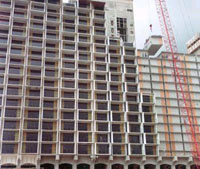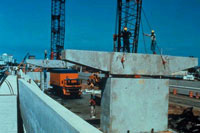In 1950, the completion of the Walnut Lane Memorial Bridge in Philadelphia, Pennsylvania, signaled the beginning of the precast concrete industry in North America. Virtually unknown in the United States until the construction of this prestressed concrete bridge, today, precast concrete structures, including bridges, are commonplace in the United States.
Precast concrete is widely used in low- and mid-rise apartment buildings, hotels, motels, and nursing homes. The concrete provides superior fire resistance and sound control for the individual units and reduces fire insurance rates.
 Precast concrete is also a popular material for constructing office buildings. The walls of the building can be manufactured while the on-site foundations are being built, providing significant time savings and resulting in early occupancy.
Precast concrete is also a popular material for constructing office buildings. The walls of the building can be manufactured while the on-site foundations are being built, providing significant time savings and resulting in early occupancy.
The speed and ease with which precast structures can be built has helped make precast a popular building material for parking structures. Precast concrete allows efficient, economical construction in all weather conditions and provides the long clear spans and open spaces needed in parking structures. For stadiums and arenas, seating units and concrete steps can be mass produced according to specifications, providing fast installation and long lasting service. In addition, pedestrian ramps, concession stands, and dressing room areas can all be framed and constructed with precast concrete.
The smooth surfaces produced with precast concrete and the ability of precast, prestressed concrete to span long distances makes precast suitable for use in manufacturing and storage structures. Additional applications for precast concrete include piles and deck for railroad and highway bridges, railway crossties, burial vaults, educational institutions, commercial buildings such as shopping malls, and public buildings including hospitals, libraries, and airport terminals.
A benefit of precast concrete is that the product is created in ideal manufacturing conditions. Although some products are cast outdoors, especially in temperate climates, many precast plants operate indoors where the climate can be fully controlled.
Standard or Special
 There are two types of precast products. Standard products such as beams, decks, and railroad ties are shaped in one way and used repeatedly. The other type of product is a specialty product, designed especially for the building, bridge, or structure where it will be used. Most precast companies have their own carpentry shops where skilled workers create forms for the many specialty-precast products available. Architectural concrete is often cast specially for each new project.
There are two types of precast products. Standard products such as beams, decks, and railroad ties are shaped in one way and used repeatedly. The other type of product is a specialty product, designed especially for the building, bridge, or structure where it will be used. Most precast companies have their own carpentry shops where skilled workers create forms for the many specialty-precast products available. Architectural concrete is often cast specially for each new project.
The forms, whether standard or specialty, are well oiled. Concrete is placed in the forms and allowed to cure. After curing, the product is carefully lifted from the form and taken to a yard for further curing before it is shipped to the project site The form is then carefully cleaned and prepared for the next batch of concrete. Many precasters can turn over their forms every one or two days.
More information is available at the National Precast Concrete Association
For more information on precast concrete,
click here.